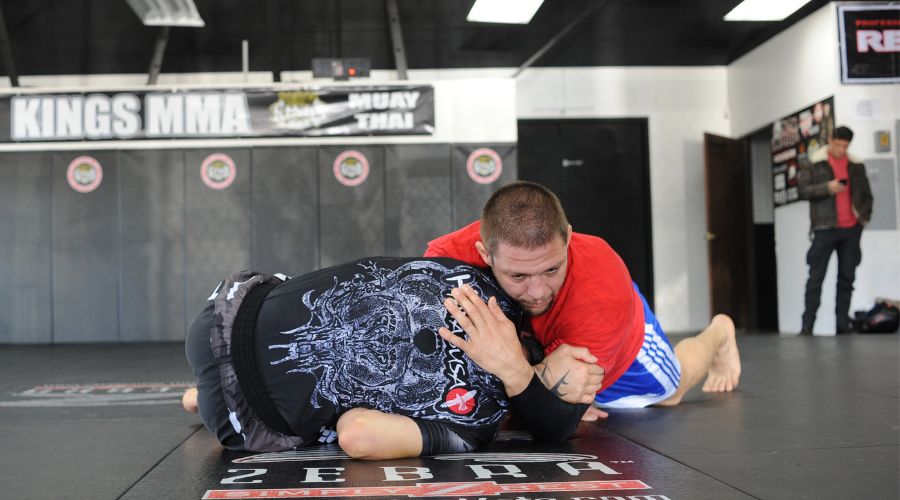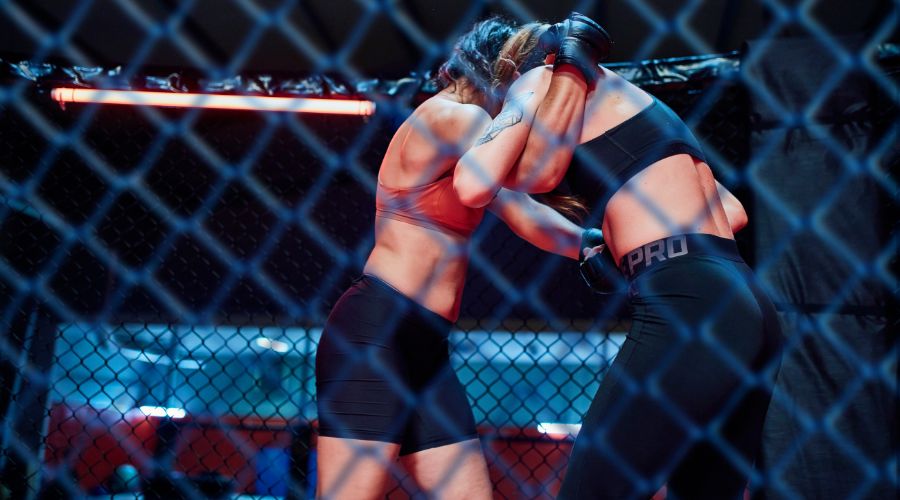Many different grappling martial arts have found their way into mixed martial arts. They are used to different extents, but MMA has become a unique sport with unique specifics on striking and grappling. But what is grappling for MMA?
Grappling for MMA is a specific style of grappling using techniques from martial arts like BJJ, wrestling, and judo. Still, it utilizes striking and the cage for offense and defense, becoming a separate style altogether.
BJJ and other grappling styles have a great deal of crossover. Still, you must consider some crucial differences if you plan to use your grappling skills in an MMA fight.
What is Grappling?
Grappling is a universal term encompassing all martial arts that use close-range grips and holds to control another person by manipulating his position, throwing him to the ground, or applying a painful hold like a joint lock or a choke.
Grappling techniques include many elements serving at least one of the purposes I just outlined. They can be cinches, takedowns, throws, pins, holds, joint locks, and various chokes or strangles. The common thing is each of them is a very close-range technique used to control or manipulate the opponent’s body in a certain way.
In language, wrestling and grappling are interchangeable and mean the same thing. Still, many variables exist between different grappling styles, so we can split the two terms into different grappling categories for ease of use.
- Submission grappling– is a form of grappling where the end goal is to force the opponent to admit defeat by applying a submission. The best example of such martial art is BJJ. Other martial arts like judo and sambo also allow submissions but focus on effective throws.
- Wrestling– Аre considered grappling styles where submissions are not allowed, and the main purpose is to throw the opponent on the ground, pin his back, or push him outside the boundaries of the match area.
What Is Grappling For MMA?

Most grappling combat sports do not allow any form of striking and focus solely on grappling.
But mixed martial arts is a complex sport with a very liberal ruleset compared to most others. It combines all areas of fighting, including striking and grappling, which creates a different twist on both.
In pure grappling sports like Brazilian jiu-jitsu or freestyle wrestling, there is no danger of getting punched or kicked in the face, so the stance you take, the way you set up the sequences, and the way you move into positions are all done in a certain way.
Suddenly, when you can eat a knee, you cannot move forward with your head at waist level or lie around in full mount, calmly entertaining in your mind the best ways to escape.
Leg locks are another example of a powerful technique in submission grappling competition that does not translate as easily to MMA, where the two hands needed to control the leg leave you with no options to defend against punches.
The possibility of striking on the ground in MMA changes every single aspect of grappling. This is, of course, not to say grappling martial arts like BJJ don’t work in MMA. This couldn’t be further from the truth, but everything must be considered and applied relatively safely against strikes.
This is why many tactics and more advanced techniques found in sports BJJ cannot be done in the cage. The time and setups needed to finish them are often impossible in MMA.
But with the striking also comes new possibilities for submissions and holds. Even on the feet, takedowns are often set up by strikes as a counter to strikes.
On the ground, a submissions expert can seamlessly blend ground and pound to guard pass or open up new submissions opportunities by forcing the opponent into position through strikes.
Another key factor is the cage in MMA. Takedown offense, defense, clinching, and even ground and pound and submission attempts near the wall differ from those on an open mat.
The cage and all of the techniques and tactics it allows are unique to MMA, and even styles like kudo or combat sambo, where striking and grappling are used simultaneously, cannot prepare you for it.
Overall, grappling for MMA is a specific skill set that needs to be developed. While having a solid base in BJJ or wrestling is excellent, these skills must always be modified in a way applicable to MMA.
Types of Grappling Techniques Used in MMA
The beauty of MMA is it uses everything that works under the rules, which combines vast amounts of techniques from different martial arts. Here are the main categories of grappling techniques used in MMA.
Clinch Fighting
Clinches are the first transition point between striking and grappling, and many striking sports also allow them to some extent. The clinch is a standing close-range position where you hold the opponent’s body, arms, or head. From there, you can strike or transition the fight to the ground with a throw or a trip.
Takedowns
Takedowns are used to force the opponent to the ground. The most commonly used ones come from wrestling, like the single and double-leg takedowns, with the addition of foot sweeps, ankle picks, arm drags, and many others. Takedowns and takedown defense are crucial in MMA because they determine who decides where the fight occurs.
Throws
Throws are grappling techniques with which you destabilize your opponent, lift him off the ground, and then throw him down. In the ideal case, you should remain standing after the opponent hits the ground.
Still, it’s usually better to follow him in MMA and land in a dominant position. Throws can be hip throws, shoulder and back throws, sacrifice throws, and many more variations.
Submissions
Submissions are one of the best ways to win an MMA fight. Placing the opponent in a painful hold where he either has to submit or suffer serious damage is what a submission is.
There are far too many ways to hurt someone this way, but the most common ones used in MMA are chokes like the rear naked choke and guillotine and joint locks like armbars and heel hooks.
Defensive Grappling Techniques
Here we can place many techniques to defend against the attacks I listed above. Each attack be it a takedown, throw, or submission, can be defended and countered. Sprawls, reversals, sweeps, shrimping, and bridging are defensive grappling techniques used in MMA.
Is Grappling Better Than Striking In MMA?

In the early days of MMA, it became crystal clear a pure grappler would almost always beat a pure striker. The grappler can decide and enforce where the fight takes place, and while on the feet, everyone has at least some chance of landing a punch. Once you hit the ground, you are doomed without skills.
But those days are long gone, and even lower-level MMA fighters have some skills in all areas. If you watch a higher number of MMA fights, the higher the level, the harder it is for fighters to keep their opponent on the ground and to apply submissions.
Takedown and submission defense are ever-improving, and watching UFC championship fights, we can see fighters spend more time on their feet than they do on the canvas. Even expert grapplers like Islam Makhachev and Charles Oliveira must rely significantly on their punches and kicks at the level they fight.
So, at a high level of MMA, striking and grappling are equally important, and the ability to blend them together may have even more significance. The higher you go in level, the more time fighters spend on their feet.
But grappling is still much more important than striking on the more beginner levels. I’ve been to many amateur and lower-level pro-MMA events and can tell you 90% of the fights go to the ground at a certain point and usually stay there.
So, while you can get by with rudimentary striking skills as an amateur, you will quickly drown if you don’t know what to do on the ground.
BJJ vs. MMA Grappling
It should be apparent with everything said until now that BJJ and MMA grappling, or even what some call BJJ for MMA, is different. The original form of Brazilian Jiu-Jitsu was used extensively by the Gracies in their challenges, and early UFC events are much more similar to what we see today used in the world of MMA.
But in modern sports BJJ has moved away from that in favor of a more intricate and complex grappling-only game. Many highly complex and elaborate techniques must be set up in specific ways. There are berimbolos, spider guards, de la Riva guards, and many other moves created solely for grappling competition and have no place in a cage fight.
Then the gi and every single grip, technique, and submission associated with it are strictly BJJ-specific and cannot be used in MMA. The dynamic of no-gi grappling is much closer to MMA fighting, but the lack of striking makes the two different. The closest form of BJJ to MMA currently is Combat Jiu-Jitsu, which allows palm strikes and slaps on the ground.
To summarize in a few points:
- BJJ has more grappling techniques and complexity on the ground
- MMA grappling must always deal with striking, and this is used offensively and defensively
- ММА grappling requires more physical attributes, while BJJ is more tactical
Summary
Grappling is something every MMA fighter must be proficient in. While Brazilian Jiu-Jitsu and wrestling have many crossover skills, they need to be modified to answer the respective dangers and specifics if you want to use them effectively in a fight. This is why grappling for MMA can be considered a separate style that must be studied and trained.
